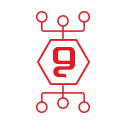How to choose an information security tool for the organization
Choosing the right cybersecurity tools to protect your organization is a critical decision that requires careful consideration and thought.
Here's a step-by-step guide to help you make informed choices:
Do a risk assessment: Assess the specific information security risks your organization faces.
Identify potential threats, vulnerabilities, and potential impact of a security breach.
This assessment will serve as a basis for choosing tools that meet the unique needs of your organization.
Define your security requirements: Clearly define your organization's security requirements.
Consider aspects such as data protection, network security, endpoint security and regulatory compliance.
Understanding your specific needs will guide you in choosing the right tools for your security goals.
Understand your infrastructure: Before choosing information security products, it is important to examine the prerequisites, the types of devices, the operating systems and the applications in use.
This knowledge is essential for choosing compatible and efficient tools throughout your network and avoiding failures that could have been avoided.
Choose a comprehensive security package: Look for cyber security tools that offer a comprehensive suite of services.
This may include anti-virus software, firewalls, intrusion detection/prevention systems, secure email gateways and endpoint protection. An integrated approach under one platform ensures that all aspects of your organization's security are covered.
User friendly interfaces: Choose tools with user-friendly interfaces.
Cyber security tools will do their job, when they are actively used and properly configured.
Choose solutions that allow for easy management and monitoring, allowing your team to maximize their effectiveness.
Communication and integration: Make sure the chosen tools can integrate seamlessly with your existing IT infrastructure. Compatibility with your current systems and the ability to share threat intelligence across tools improves the overall effectiveness of your cybersecurity strategy.
Small and medium-sized organizations will often prefer tools under one manufacturer in order to optimize the communication between the information security tools and reduce the resources required for their maintenance.
Manufacturer and integrator reputation: Research and examine the reputation of the information security tool manufacturer.
More importantly, look for integrators who are highly knowledgeable not only in implementation, but in ongoing maintenance.
An information security product that is not maintained, will not meet the goals for which it was purchased.
Cost and ROI: Examine the return on investment (ROI) of cyber security tools.
Evaluate the long-term benefits these tools bring to your organization's security posture.
In conclusion: Choosing a cyber security tool is a strategic decision that requires a thorough understanding of your organization's needs, infrastructure and potential risks.
By conducting a comprehensive risk assessment, defining specific requirements, and considering factors such as scalability, integration, and vendor reputation, you can build a strong cybersecurity defense tailored to your organization's unique challenges.
The author: Zabri Idan, VP of expert services and information security at Genie
You may be interested in:

אירוע משפחות סוף קיץ 2025


פישינג בעסקים: איך לזהות, למנוע ולהגיב נכון


החשיבות של סריקות פגיעויות באבטחת סייבר






